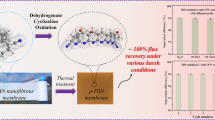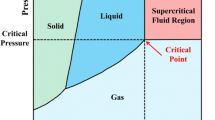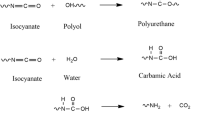Abstract
In this study, flexible and open cell polyurethane foams were formulated and chemically modified with organosilane to be used as a sorbent system for oil spill cleanup. Six polyurethane foams with different densities and three oil types with different viscosities were investigated. Moreover, sorbents were characterized based on their surface modification and sorption capacities. The main results indicated that the surface treatment on the solid fraction of the foam was effective, observing by the contact angle, thereby increasing the hydrophobicity of the samples. Cell morphology and foam density directly affect the sorption capacity of foams. Foams with high densities are indicated for oils with low viscosity, and foams with low densities are indicated for viscous oils. The oil sorption capacity also depends on oil viscosity (and temperature).
Similar content being viewed by others
References
Wu D, Fang L, Qin Y, Wu W, Mao C, Zhu H (2014) Oil sorbents with high sorption capacity, oil/water selectivity and reusability for oil spill cleanup. Mar Pollut Bull 84(1–2):263–267
Aljaroudi A, Khan F, Akinturk A, Haddara M, Thodi P (2015) Risk assessment of offshore crude oil pipeline failure. J Loss Prev Process Ind 37:101–109
Keshawy M, Farag RK, Gaffer A (2019) Egyptian crude oil sorbent based on coated polyurethane foam waste. Egypt J Petroleum. https://doi.org/10.1016/j.ejpe.2019.11.001
Ge J, Zhao HY, Zhu HW, Huang J, Shi LA, Yu SH (2016) Advanced sorbents for oil-spill cleanup: recent advances and future perspectives. Adv Mater 28(47):10459–10490
Lim TT, Hunag X (2007) Evaluation of kapok (Ceibapentandra (L.) Gaertn.) as a natural hollow hydrophobic–oleophilic fibrous sorbent for oil spill cleanup. Chemosphere 66:955–963
Shenkmann L, Stokstad E (2010) Gulf oil disaster. AAAS 328:1214–1225
Bai Y, Bai Q (2014) Subsea pipeline integrity and risk management. In: Oil spill response plan. Elsevier, Amsterdam, pp 377–390. ISBN: 9780123946485. https://doi.org/10.1016/B978-0-12-394432-0.00018-4
Nordvik AB, Simmons JL, Bitting KR, Lewis A, Kristiansen TS (1996) Oil and water separation in marine oil spill clean-up operations. Spill Sci Technol Bull 3(3):107–122
Wei Q, Oribayo O, Feng X, Rempel GL, Pan Q (2018) Synthesis of polyurethane foams loaded with TiO2 nanoparticles and their modification for enhanced performance in oil spill cleanup. Ind Eng Chem Res 57:8918–8926
Bayat A, Aghamiri SF, Moheb A, Vakili-Nezhadd GR (2005) Oil spill cleanup from sea water by sorbent materials. Chem Eng Technol 28(2):1525–1528
Tanobe VOA (2007) Desenvolvimento de sorventes à base de espumas de poliuretanos flexíveis para o setor do petróleo. Tese (Doutorado em Engenharia e Ciência dos materiais) – Universidade Federal do Paraná, Curitiba
Li H, Liu L, Yang F (2013) Oleophilic polyurethane foams for oil spill cleanup. Procedia Environ Sci 18:528–533
Adebajo MO, Frost RL, Kloprogge JT, Carmody O, Kokot S (2003) Porous materials for oil spill cleanup: a review of synthesis and absorbing properties. J Porous Mater 10:159–170
Payne KC, Jackson CD, Aizupurua CE, Rojas OJ, Hubbe MA (2012) Oil spills abatement: factors affecting oil uptake by cellulosic fibers. Environ Sci Technol 46(14):7725–7730
Duong HTT, Burford RP (2006) Effect of foam density, oil viscosity, and temperature on oil sorption behavior of polyurethane. J Appl Polym Sci 99:360–367
Liu Y, Ma J, Wu T, Wang X, Huang G, Liu Y, Qiu H, Li Y, Wang W, Gao J (2013) Cost-effective reduced graphene oxide-coated polyurethane sponge as a highly efficient and reusable oil-absorbent. ACS Appl Mater Interfaces 5:10018–10026
Reynolds JG, Coronado PR, Hrubesh LW (2001) Hydrophobic aerogels for oil-spill clean up—synthesis and characterization. J Non-Cryst Solids 293(1–3):127–137
Chung S, Suidan MT, Venosa AD (2011) Partially acetylated sugarcane bagasse for wicking oil from contaminated wetlands sugarcane. Chem Eng Technol 34(12):1989–1996
Li H, Liu L, Yang F (2012) Hydrophobic modification of polyurethane foam for oil spill cleanup. Mar Pollut Bull 64:1648–1653
Armenta JLR, Heinze T, Martínez AMM (2004) New polyurethane foams modified with cellulose derivatives. Eur Polymer J 40(12):2803–2812
Atta AM, Brostow W, Datashvili T, El-Ghazwy RA, Lobland HEH, Hasana AM, Perez JM (2013) Porous polyurethane foams based on recycled poly(ethylene terephthalate) for oil sorption. Polym Int 62(1):116–126
Zhu Q, Pan Q, Liu F (2011) Facile removal and collection of oils from water surfaces through superhydrophobic and superoleophilic sponges. J Phys Chem 115:17464–17470
Santos OSH, da Silva MC, Yoshida MI (2017) Synthesis and performance of different polyurethane foams as oil sorbents. J Appl Polym Sci 134(41):45409
Król P, Król B (2012) Surface free energy of polyurethane coatings with improved hydrophobicity. Colloid Polym Sci 290:879–893
Li B, Liu X, Zhang X, Chai W, Ma Y, Tao J (2015) Facile preparation of graphene-coated polyurethane sponge with superhydrophobic/superoleophilic properties. J Polym Res 22:190
Xie X, Ye M, Hu L, Liu N, McDonough JR, Chen W, Alshareef HN, Criddle CS, Cui Y (2012) Carbon nanotube-coated macroporous sponge for microbial fuel cell electrodes. Energy Environ Sci 5:5265
Keshavarz A, Zilouei H, Abdolmaleki A, Asadinezhad A (2015) Enhancing oil removal from water by immobilizing multi-wall carbon nanotubes on the surface of polyurethane foam. J Environ Manage 157:279–286
Nikkhah AA, Zilouei H, Asadinezhad A, Keshavarz A (2015) Removal of oil from water using polyurethane foam modified with nanoclay. Chem Eng J 262:278–285
Peng L, Yuan S, Yan G, Yu P, Luo Y (2014) Hydrophobic sponge for spilled oil absorption. J Appl Polym Sci 131(20):40886
Abdelmouleh M, Boufi S, Ben Salah A, Belgacem MN, Gandini A (2002) Interaction of silane coupling agents with cellulose. Langmuir 18:3203–3208
Lu N, Oza S (2013) Thermal stability and thermo-mechanical properties of hemp-high density polyethylene composites: effect of two different chemical modifications. Compos B 44:484–490
Gwon JG, Lee SY, Doh GH, Kim JH (2010) Characterization of chemically modified wood fibers using FTIR spectroscopy for biocomposites. J Appl Polym Sci 116:3212–3219
Gu R, Sain MM (2013) Effects of wood fiber and microclay on the performance of soy based polyurethane foams. J Polym Environ 21:30–38
Wu Z, Li C, Liang H, Chen J, Yu S (2013) Ultralight, flexible, and fire-resistant carbon nanofiber aerogels from bacterial cellulose. Angewandte 52(10):2997–3001
Cunha AG, Freire C, Silvestre A, Neto CP, Gandini A, Belgacem MN, Chaussy D, Beneventi D (2010) Preparation of highly hydrophobic and lipophobic cellulose fibers by a straightforward gas–solid reaction. J Colloid Interface Sci 344:588–595
Fenner BR, Zimmermann MVG, da Silva MP, Zattera AJ (2018) Comparative analysis among coating methods offlexible polyurethanefoams with graphene oxide. J Mol Liq 271:74–79
Acknowledgements
This research was supported by the National Council for Scientific and Technological Development (CNPq). The experiment was assisted by Polymers Laboratory (LAPOL), Central Laboratory of Microscopy and Laboratory of Materials Chemical Reasearch at the University of Caxias do Sul.
Author information
Authors and Affiliations
Corresponding author
Additional information
Publisher's Note
Springer Nature remains neutral with regard to jurisdictional claims in published maps and institutional affiliations.
Rights and permissions
About this article
Cite this article
Zimmermann, M.V.G., Zattera, A.J., Fenner, B.R. et al. Sorbent system based on organosilane-coated polyurethane foam for oil spill clean up. Polym. Bull. 78, 1423–1440 (2021). https://doi.org/10.1007/s00289-020-03169-5
Received:
Revised:
Accepted:
Published:
Issue Date:
DOI: https://doi.org/10.1007/s00289-020-03169-5














